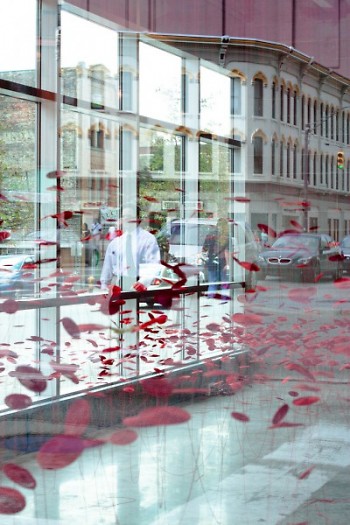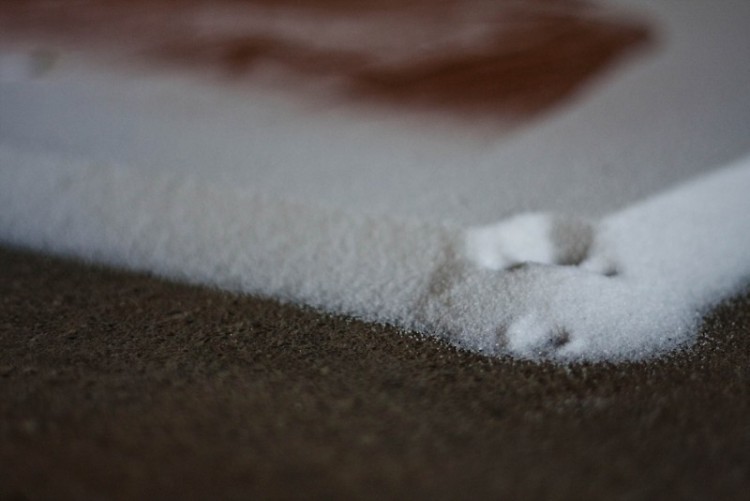
Lure/Wave, Beili Liu /Yodraws on Flickr (Rapidian Flickr group)

Salt & Earth, Young Kim /Molz on Flickr (Rapidian Flickr group)
"To see or not to see. That's the question."
— Karl Gude, Michigan State University, via Twitter
In the midst of all the hubbub and hurly burly of ArtPrize, it's easy to lose the art. The social experiment part of the event seems like a success, but the energy generated by the large crowds juxtaposed with the sheer overload of works of dodgy quality sometimes makes the art feel like an afterthought. It's great that so many people are looking at so much art. But how much of it are we seeing?
Especially when it comes to the busy weekend peak times, and especially when it comes to the pieces in the top 10, it can be difficult to engage the art and give it the proper attention. Fortunately, two of the best of this year’s ArtPrize top 10 draw their power from encouraging deep meditative states.
Beili Liu’s “Lure/Wave” is a meditation on interconnectedness. The red discs connected to one another by long threads bring to mind the color of blood. The soft air currents in the installation evoke the breath that animates and connects us all. It is a work that feels alive, subtly reacting to each ephemeral moment. Staking out a spot by the window and looking at "Lure/Wave" for a long time — five or 10 minutes — while the crowds bustle by is an amazing experience (and how this writer decided that this piece would get his precious final round vote).
In a similar vein, Young Kim wrote in his artist statement that his work “continually revolves around meditation over time, memory, and the state of the human condition.” His entry this year, “salt & earth (garden for Patricia),” once again presents a potent reflection on the impermanence of existence. It is a work of impressive technical prowess and conceptual depth. But “salt & earth” feels somehow lesser than last year's entry.
Part of that diminution may be due to the installation’s location. Kim's 2009 breakout work at 45 Ottawa drew part of its effectiveness from its spacious, raw urban environment, which enhanced the contemplative nature of the work. Because of all the attention he received last year, now he’s in the high-traffic Grand Rapids Art Museum. On Friday night, there were lines snaking throughout the building. Wall-to-wall humanity filed through quickly, ritually circumambulating the piece in some claustrophobic ritual. That kind of setting shuts down deep reflection and replaces it with an anxious feeling. It's not the fault of Young Kim, the GRAM, or the audience. But, sadly, it does make it harder to engage the work to its full potential.
I've heard arguments that Kim's entry this year is lacking because it is derivitive of his previous work. That's a bogus argument, though. Kim’s work is reminiscent of Tibetan sand mandalas — an ancient artform that has lost none of its ability to communicate and inspire. This year, we’re fortunate to have a real sand mandala constructed by a Tibetan monk as an ArtPrize entry. If you like “salt & earth,” it is worth making the trek over to Grand Central Market to view Geshe Ngarampa Thupten Tsondu’s work, which itself is a gorgeous meditation on impermanence. In both cases, the artists spent time and careful attention creating something that will deteriorate and ultimately be swept up and cease to exist — much like all of us.
Those brief moments of realization, when the observer and the observed fall away — those are the moments when we move beyond looking and start seeing. All it takes is slowing down a bit.
The Rapidian, a program of the 501(c)3 nonprofit Community Media Center, relies on the community’s support to help cover the cost of training reporters and publishing content.
We need your help.
If each of our readers and content creators who values this community platform help support its creation and maintenance, The Rapidian can continue to educate and facilitate a conversation around issues for years to come.
Please support The Rapidian and make a contribution today.
Comments
brian, it is fabulous to note that there CAN actually be meditative qualities amongst the circusy bullshit of this event. having said that, can others add to entries that would potentially fall under this category, but did not make the top 10? i'd like to see them, but was so overwhelmed by mass amounts of people and moving elephant heads, that i've only found little treasures by happening upon them. really. so... allow me to start with just one:
'the scar project' by nadia myre. myre is a canadian artist exploring ways in which people forgive, and in which they are/have been scarred. over 400 small canvases are on display at kendall college right now, half of which were actually created by grand rapids participants during artprize. myre asks people to sit down and stitch a scar (physical or emotional) onto a small canvas that she provides (10 x 10"), and then write a brief description to accompany the work. the result is an emotionally moving, visually stunning body of work, where (if you allow yourself) the viewer can be connected with the numerous experiences (and scars) of our neighbors.
if the space is too emotionally overwhelming, or you are the type that needs quiet space to digest work (okay, hi), have a look at her book where text and images rest side-by-side, and you have time (and privacy) to feel as much as you'll allow.
ok, for a better description, look here:
http://www.artprize.org/artists/public-profile/49862